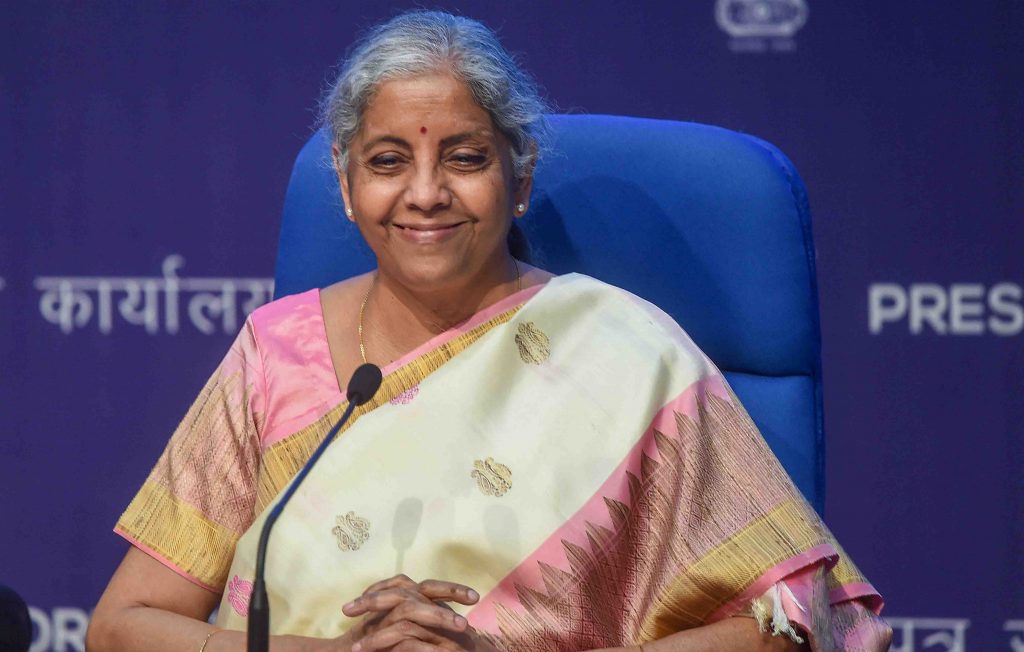New Delhi: Finance Minister Nirmala Sitharaman unveiled Tuesday a bigger Rs 39.45 lakh crore Budget, with higher spending on highways to affordable housing. This was done with a view to fire up the key engines of the economy to sustain a world-beating recovery from the pandemic. Nirmala Sitharaman primed up spending on infrastructure to create jobs and boost economic activity. However, Sitharaman did not tinker with income tax slabs or tax rates.
Her Budget for the fiscal year beginning April 2022 proposed a massive 35 per cent jump in capital expenditure to Rs 7.5 lakh crore. It also included rationalisation of customs duty, an extension of time for setting up new manufacturing companies and plans for starting a digital currency and taxing crypto assets.
At a post-Budget press conference, Sitharaman parried questions on the middle class not being given relief in the form of tax cuts or raising exemption. She said the Budget has not raised taxes last year or this year.
Also read: The untold, unwritten custom on Budget day for any Finance Minister
“We did not try to raise money through higher taxes as we did not want to burden people with taxes during a pandemic,” Sitharaman said.
Just like last year, the Budget gave a big boost for infrastructure spending – from 5G spectrum auction, expanding national highways by 25,000 kms, inter-linking of rivers and manufacturing of 400 new generation Vande Bharat trains.
“The overall sharp rebound and recovery of the economy is reflective of our country’s strong resilience,” Sitharaman said in her Budget speech in the Lok Sabha. She vowed to lay the foundation for faster growth.
The Budget prioritised economic expansion over fiscal consolidation. “This Budget continues to provide the impetus for growth,” she asserted.
Sitharaman also announced plans to start a central bank-backed digital currency in the next fiscal to usher in cheaper, more efficient currency management.
Also, a 30 per cent tax is proposed to be levied from April 1 on profits from digital asset transactions, including cryptocurrencies and non-fungible tokens (NFTs), as India keeps pace with the global move toward virtual financial instruments.
The crypto market in India grew 641 per cent in the year through June 2021, according to an October report from ‘Chainalysis’, an industry research firm.
The Budget raised duties on imported headphones, loudspeakers, smart meters used by power distribution companies and solar panels to bolster local manufacturing and create jobs. It also proposed to withdraw the anti-dumping tax on some steel products and extend an import duty exemption on scrap for another year as local consumers grapple with high prices for the alloy.
Sitharaman also announced a new battery swapping policy for electric vehicles, allocated Rs 60,000 crore for piped water to 3.8 crore homes, provided Rs 19,500 crore worth of additional production-linked incentives for solar modules to boost local manufacturing and classified data storage as an infrastructure sector for providing cheaper and easier financing.
To boost infrastructure, the Finance Minister said contracts to lay optical fibre in rural areas will be awarded, Rs 48,000 crore has been set aside for affordable housing, four multi-modal logistics parks will be set up, a string of ropeway projects are planned in hilly areas, a battery swapping policy will be announced, high priority has been accorded for Ken-Betwa river link project and defence R&D opened to private players.
Also, plan to use biomass pellets in thermal power plants in bid to rely less on coal was announced.
An auction of 5G telecom spectrum is planned in 2022, digital financial services are planned to be expanded and 1.5 lakhs post offices are to be connected to the core banking platform for financial inclusion and banking access to the non-banked population.
On the other hand, food, fertiliser and other subsidy outgo has been cut by 39 per cent.
Total government spending will be 4.6 per cent more than the current year and additional support of Rs 1 lakh crore to states has been announced.
The government continues on its path of supply-side economics and plans to boost investments, thereby increasing jobs and consumption instead of directly announcing any monetary relief to the lower end of the population.
The fiscal deficit, which unexpectedly rose to 6.9 per cent of the GDP for the current fiscal year ending March 31, 2022, is projected to come down to 6.4 per cent next year and 4.5 per cent by 2025-26.
India’s economy is projected to grow by 9.2 per cent in the current fiscal, before slowing to 8-8.5 per cent in 2022-23 (April 2022 to March 2023). It had contracted by 6.6 per cent in the fiscal year ended March 31, 2021.
The Budget’s ‘approach is driven by seven engines’, Sitharaman said, listing roads, railways, airports, ports, mass transport, waterways and logistics infrastructure as the key areas. “All seven engines will pull forward the economy in unison, complemented by energy transmission, IT communication, water and sewerage sector and social infrastructure,” she said.
On the direct tax front, to further ease compliances for taxpayers, a new IT return system will be introduced and litigation will be reduced by restricting appeal rights of revenue authorities for consecutive years. It marginally increased the time limit to commence production by March 31, 2024 for units opting for the beneficial corporate tax rate of 15 per cent.
To provide impetus to trust-based governance as a concept, an updated tax return system has been introduced wherein a taxpayer can file a tax return upon payment of specified taxes within two years from the end of the relevant assessment year.
To give a boost to the start-up community, Sitharaman capped the surcharge on long-term capital gains at 15 per cent now.
